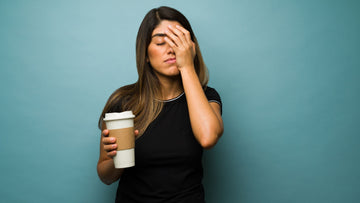
For many of us, starting our day with a comforting cup of coffee is a daily ritual. We relish the warmth and the jolt of energy it provides. This ritual, however, can sometimes lead to dependency. Caffeine addiction, often dismissed as harmless, can have a range of health implications. If you've ever tried to quit coffee, you'll likely be familiar with the withdrawal symptoms, particularly the dreaded headaches. In this guide, we'll explore caffeine addiction, its effects on the body, and, most importantly, how to break free from it without the painful headaches.
Understanding Caffeine Addiction
Caffeine addiction is a widespread but often underestimated issue. Caffeine, the central nervous system stimulant found in coffee, tea, energy drinks, and even chocolate, can lead to physical and psychological dependence. With repeated use, the body builds up a tolerance to caffeine, requiring more to achieve the same stimulating effects.
The Prolonged Effects of Caffeine
One reason caffeine is so addictive is its longevity in the body. According to research, the half-life of caffeine (the time it takes for the body to eliminate half of it) varies from person to person but averages around 3 to 5 hours. However, some individuals can experience its effects for up to 10 hours, especially if they're sensitive to caffeine or have a slower metabolism.
These lingering effects can wreak havoc on your sleep patterns, disrupt your nervous system, and lead to a host of other issues. Over time, this continuous cycle can result in dependence.
What Caffeine Withdrawal Feels Like
Caffeine withdrawal is a real phenomenon, and it can be unpleasant, to say the least. When you decide to cut down or quit caffeine, your body reacts to the absence of the stimulant it has grown accustomed to. Common withdrawal symptoms include headaches, fatigue, irritability, difficulty concentrating, and mood swings. The intensity and duration of these symptoms can vary from person to person, but headaches are often a significant part of the withdrawal experience.
The Why Behind the Pain
But why do headaches happen during caffeine withdrawal? They occur because caffeine constricts blood vessels in the brain. When you suddenly stop consuming caffeine, those blood vessels expand, leading to increased blood flow and potential headaches. Moreover, caffeine withdrawal can also affect neurotransmitters like adenosine, which play a role in pain perception.
Tips to Overcome Caffeine Addiction
Now, the big question: how can you give up coffee without enduring those dreaded headaches and other withdrawal symptoms? While it's not entirely painless, there are strategies to make the transition smoother:
-
Gradual Reduction using Not Coffee: One of the most effective methods is a gradual reduction in caffeine intake. Start by mixing half of your regular coffee with half of a caffeine-free alternative like Not Coffee. Gradually decrease the coffee portion while increasing Not Coffee over the course of a week or two. This method will be less of a shock to your body than going cold turkey.
-
Stay Hydrated: Proper hydration can help alleviate some withdrawal symptoms. Drink plenty of water throughout the day to stay hydrated, as dehydration can exacerbate headaches.
-
Get Adequate Sleep: Focus on improving your sleep hygiene during this transition period. A well-rested body can better cope with withdrawal symptoms.
-
Herbal Teas: Many herbal teas offer warmth, comfort and hydration without the caffeine jolt.
-
Mindful Eating: Pay attention to your diet. Nutrient-rich foods can help support your body as it adjusts to the absence of caffeine.
-
Exercise: Regular exercise can boost your mood and energy levels, which can counteract some of the fatigue associated with withdrawal.
The Role of Not Coffee
In your journey to give up coffee, Not Coffee can be a valuable ally. Not Coffee offers a caffeine-free alternative that captures the rich, comforting flavors of coffee without the caffeine content. As mentioned earlier, you can easily incorporate Not Coffee into your transition by gradually replacing your coffee with it. This process eases the shock to your system and can significantly reduce the severity of withdrawal symptoms, including headaches.
The Road to Recovery
How Long Does it Take?
The duration of caffeine withdrawal varies from person to person, but it typically lasts for about two weeks. During this time, your body is adjusting to the absence of caffeine and regaining its natural balance.
Patience and Persistence
Breaking free from caffeine addiction might not be easy, but it's certainly worth it. As your body detoxifies from caffeine, you'll begin to notice positive changes. Your sleep patterns may improve, anxiety levels might decrease, and you'll likely experience more consistent energy throughout the day.
Remember, every journey is unique. Patience and persistence are your allies. If you find yourself slipping back into old habits, don't be too hard on yourself. The path to a caffeine-free lifestyle can be winding, but with the right strategies and support, you can overcome caffeine addiction and enjoy a healthier, more balanced life.
So, as you embark on this caffeine-free journey, know that you're taking a significant step towards better health and well-being. Embrace the change, and with the help of gradual transitions and caffeine-free alternatives like Not Coffee, you'll find that giving up coffee doesn't have to come with those dreaded headaches. Cheers to a brighter, caffeine-free future!





